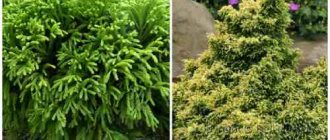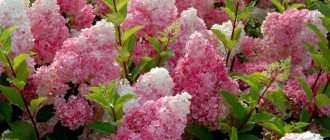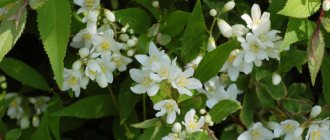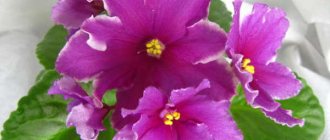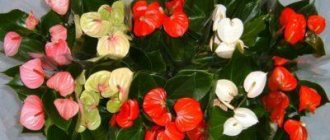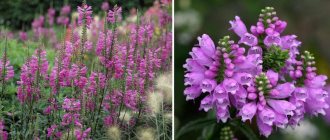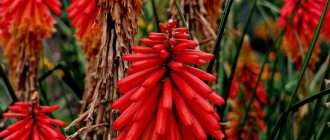History of the name
The name “hydrangea” was given to the plant by Philibert Commerson, it is derived from the Latin hortus (garden). Since Hortense was a common female name in this era, many versions arose about the woman to whom this name could be dedicated: from Nicole-Reine Lepot, who could be called Hortense in the family, to Princess Hortense - the sister of Prince of the Holy Roman Empire Karl Heinrich of Nassau-Siegen .
Later, European botanists-taxonomists gave the plant the name Hydrangea, which can be translated as “vessel of water” (ancient Greek ὕδωρ - water, ἄγγος - vessel). According to one version, the name was given to hydrangea for the shape of the seed pods, reminiscent of a jug, according to another - for its moisture-loving nature.
In Japan they are called Ajisai. Writing the name of a flower in hieroglyphs can be translated as “purple solar flower”, “flower similar to the purple sun”.
Location
In the southern regions of Russia, choose a place that is bright but protected from the afternoon scorching sun (partial shade). From the eastern, northwestern part of the site there is a gazebo, wall of a house or barn.
In the central regions of Russia and northern regions, choose a place that is drier and more open, warmed by the sun, but keep in mind that hydrangeas do not like prolonged exposure to direct sunlight (south and southwest side). Try not to plant hydrangea next to other water-bearing plants or large shrubs and trees - there will be competition for moisture, and the plants will have to be watered frequently.
Hydrangea: plant description
Climbing hydrangea (Hydrangea scandens) Botanical illustration from the book of Siebold and Zuccarini Flora Japonica, Sectio Prima, 1870
Most species are shrubs 1-3 m tall, some species are small trees, the rest are vines that climb the trunks of other trees to a height of up to 30 m Plants can be either deciduous or evergreen, but the widely cultivated temperate zone species are deciduous.
Hydrangeas bloom from spring to late autumn. The flowers are collected at the end of the stem into beautiful spherical inflorescences - a corymb or panicle. In most species, the flower heads contain two types of flowers: small fertile flowers in the middle and large sterile flowers at the edges. In some species, all flowers are fertile and have the same size.
The vast majority of flowers are white, but some, such as bigleaf hydrangea (Hydrangea macrophylla), can be blue, red, pink and lilac. In such species, the color often depends on the pH level (hydrogen index) in the soil: in acidic soils, the petals become blue, in neutral soils - pale beige, and in alkaline soils - pink or lilac.
Hydrangeas are one of the few plants that can accumulate aluminum, which is released from acidic soils and in some species forms compounds that give them blue tints.
The fruit of hydrangea is a 2-5-part capsule with numerous small seeds.
Plants from another closely related genus, Schizophragma, are also sometimes called hydrangeas. Among climbing plants, the most famous are Schizophragma hydrangeoides and Hydrangea petiolaris.
Hydrangea in garden design.
Hydrangeas are a great addition to the garden throughout the season. They are appropriate in gardens of any style: both strict regular ones and rural natural ones. You just need to select certain types for each garden style. Hydrangeas can be planted on the lawn either singly or in groups, in compositions with conifers or deciduous shrubs, or in flower mixborders. Abundantly flowering hydrangea bushes look advantageous, acting as a soloist in autumn compositions. Spectacular hydrangea bushes will be a wonderful decoration for a shady garden, for which it is not so easy to choose an assortment of plants. From petiole hydrangea you can create a dense hedge or screen.
Hydrangea inflorescences are excellent cut flowers. To keep them fresh longer, the ends of the shoots should be split with a sharp knife and burned.
You can also make dry bouquets from hydrangea inflorescences. The shoots are cut off at the end of flowering, when they have a rich color. They are hung in a well-ventilated area or under a canopy with the inflorescences facing down, having previously torn off the leaves. This will preserve the natural color of the flowers. To create winter compositions, dried lunaria branches with transparent pearlescent plates can be added to hydrangeas with white inflorescences.
Types and varieties of hydrangea
If you are thinking about decorating your garden with hydrangea, then first of all you should pay attention to the characteristics of the different types of this plant. Then you can choose exactly those species that will be best suited for your garden.
It is also important to know how to care for each species. For example, tree or large-leaved hydrangea must be prepared for wintering and pruned somewhat differently than paniculate hydrangea. If you know a lot about the rules for caring for such plants, then caring for them will not be difficult.
Tree hydrangea (Hydrangea arborescens)
Hydrangea
This variety is very popular among gardeners living in mid-latitudes. This plant is presented in the form of a shrub. Its height can vary from 100 to 300 centimeters. Inflorescences grow on the tips of annual stems. When the flowers just begin to open, they are light green in color; after they are fully opened, they change their color to cream or white. The most popular varieties are: “Invisible Spirit” - the flowers are pink; “Sterilis” - the inflorescences are painted white, and this plant blooms very profusely; "Annabelle" and "Grandiflora" - have very large inflorescences, painted pure white (note that paniculate hydrangea has varieties with exactly the same names).
Hydrangea Annabelle
Hydrangea Anabelle
Today, this plant can often be seen in the landscape design of modern private houses or in the design of decorative street courtyards. Tree hydrangea "Annabel" is a dome-shaped deciduous shrub that is grown exclusively for decorative purposes.
Tree hydrangea Annabelle is distinguished by its relatively large size (width). The height of the plant, depending on the variety, can reach 1.5 meters, and the width - up to 3 meters. The leaves of this plant have a soft and lightweight structure, the most common color is deep green or emerald. There is no gloss on the leaves. The leaves are oval in shape, with pointed tips. The average leaf length is up to 20 cm. A large number of leaves and massive inflorescences form a lush, loose and spreading oval-type crown.
The plant blooms in June and ends flowering in late September or early October. The flowers themselves are small - up to 2 cm in diameter, but form massive, dense spherical inflorescences up to 20 cm in diameter. The colors of the flowers at the beginning of flowering are pale green; as the inflorescence matures, they acquire a soft cream or white color.
Hydrangea paniculata
Hydrangea paniculata
Under natural conditions, such a plant has the form of a tree or shrub, the height of which can vary from 2 to 5 m. This species is considered one of the most popular among gardeners. Without replanting in the same place, this type of hydrangea can grow and develop normally for more than 40 years. The stems of this plant become lignified in a relatively short time, which is why it is considered winter-hardy. Inflorescences grow in the upper parts of this year's stems, and the flowering is notable for its abundance. However, the buds formed in the last days of June open only in August or September. The inflorescences of this type of flower have a pyramidal shape. When the flowers begin to open, they are pale green in color, and after full opening they turn white. At the end of the summer they turn light pink and then brick. When the flowering period begins to end, the flowers turn light green again. The most popular varieties are Grandiflora, Quishu, Vanilla Fraze and Tardiva.
Hydrangea Vanille fraise
Hydrangea "Vanilla Fraze"
Paniculate hydrangea "Vanilla Fraze" ("Vanilla Fraise") is a perennial plant that, under favorable conditions and proper care, lives up to 50 years. The name Vanille fraise comes from two French words: the first translates as “vanilla”, and the second means “strawberry”.
The variety was created in the French nursery Renault. Work on it was carried out from 1989 to 2003. The development of “Vanilla Fraze” was carried out by the head of this institution, Eric Reno, who received several awards for it at various exhibitions.
The variety impresses first of all with its beautiful, lush and long-lasting flowering. It begins in the first half of June (in some regions even at the end of May) and lasts until the end of September and beginning of October. Wide cone-shaped inflorescences with a sharp white tip reach a length of 30 cm. The diameter of the entire crown varies from 1.5 to 2 meters. And the bush grows up to 200 cm in height.
Large leaf hydrangea (Hydrangea macrophylla)
Large leaf hydrangea
Or garden - it is often cultivated in the garden. However, some varieties can be grown in containers indoors or on the terrace. The dense leaves have a rich green color. This year's stems are herbaceous, which is why the bush does not have very high cold resistance. It is believed that the inflorescences appear on last year’s stems, since the buds for their growth are laid in the autumn, and they begin to grow in the spring. As a rule, the inflorescences have a viburnum-shaped, umbrella-shaped form; it is also called hemispherical or Japanese. The color of the flowers depends on the pH of the soil. More recently, interesting varieties have appeared: “Endless Summer” - in acidic soil - blue color, in neutral - lilac; "Renata Stanger" - blue; “Expression” and “Romance” have double flowers.
Hydrangea paniculata Samarskya Lydia
Hydrangea Samara Lydia
“Samara Lydia” is an amazingly beautiful medium-growing paniculate hydrangea. The size of an adult plant is 1.3 meters in height and 1.1 meters in width. The Samara Lydia bush cannot be confused with any other! Even in early June, when the buds are just beginning to form, it stands out like a proud admiral from the crowd of other hydrangeas with its juicy, pubescent dark green leaves against the background of reddish stems. In the fall, when the leaves of all other varieties of hydrangeas turned yellow and began to fall off, the foliage of “Samara Lydia” delights the eye with its festive decoration until the very frost, continuing to hold the title of the main decoration of the garden and park area for the variety.
The buds at the very beginning of flowering (for central Russia this is the beginning of July) are milky white with a greenish tip. Flowers change color very quickly. By the end of July they are mostly light pink in color, by mid-August they become bright pink, and by the end of summer they finally dress up in a noble deep ruby color.
Oakleaf hydrangea (Hydrangea quercifolia)
Hydrangea oakleaf
It has low frost resistance and needs good insulation for the winter. It blooms very luxuriantly and has unusually attractive leaves. It has a height of about 2 m. The length of the paniculate inflorescences is from 10 to 30 centimeters. Flowering begins in June–July, with the flowers initially white and later turning purple.
Ground cover hydrangea (Hydrangea heteromalla)
Hydrangea groundcover
Or hydrangea variegated - a winter-hardy species. Under natural conditions, the height can reach 200–300 centimeters. Often used to form a standard form. The length of dark green leaves is about 20 centimeters. The front side is smooth, and the back side is pubescent. The loose, corymbose-shaped inflorescences are initially white, and then turn pink at the end of flowering. Flowering begins in the last days of June or the first days of July. The most popular ground cover variety is Bretschneider, which blooms profusely in rather large inflorescences of a milky white color.
Gardeners also grow hydrangeas: ashen, serrated, radiant, rough, Sargent. They also grow the climbing species petiolate hydrangea, but as mentioned above, this is not a hydrangea.
Popular varieties
In addition to the types of hydrangea, there is a division into varieties that amaze with their diversity and color palette.
Grandiflora
A widespread variety, which is distinguished by large, sterile inflorescences, pyramidal in shape. At the beginning of flowering the flowers are cream, then turn white. The end of flowering occurs in August, and the flowers acquire a green color.
Touch of pink
Compact, bush variety, proven over the years. Hydrangea of this variety grows up to 0.8 m in height, crown volume 0.6 m. The flowering period is from June to September. The inflorescences are white, then some of the flowers turn pink. In the photo, the hydrangea looks very impressive. White and pink mix is often used to decorate flower beds and alpine slides.
polar bear
An adult bush is from 1.5 to 2 meters in height and up to 1.2 meters in diameter. The inflorescences are cone-shaped, large and dense. The flowers are soft green as they grow and turn pink at the end of the season. Blooms from July to October. Does not require pruning, the crown independently forms into a giant bouquet.
Pinky winky
Large cone-shaped inflorescences are white. At the end of flowering they turn pink. Flowering period from June to October. The bushes are erect with a dense, spreading crown.
Red sensation
A hybrid variety that grows up to 2 meters in height. The inflorescences are dense, the flowering period is long. The peculiarity of the variety is its burgundy shoots.
Annabelle
Frost-resistant tree-like shrub. The height of an adult plant is only 1 meter in height. The color of the inflorescences directly depends on the acidity of the soil. The inflorescences are strong and form a spherical crown as they grow.
Silver dollar
A low shrub from 1.5 to 1.7 m, with a beautiful crown from 1.3 to 1.5 meters in diameter. The crown is dense and rounded. Young shoots and branches grow strictly vertically. The leaves are ovoid in shape with a pointed edge, and have a beautiful emerald color. The inflorescences are large, pyramidal from 20 to 25 cm. The color of the flower petals is white, at the end of flowering they are lilac-pink.
Sundae Fraise
A dwarf ornamental bush with a height of 1 to 1.2 m. Crown diameter is 1-1.2 m. Flowering is abundant, almost every shoot is crowned with an inflorescence from 20 to 25 cm, white or greenish in color. Towards the end of the season the color changes to pink.
Strawberry blossom
Decorative shrub of perennial garden hydrangea, 1-1.2 m high. The inflorescences are cream, then pinkish. At the end of the season they turn bright crimson. The length of the inflorescences is from 30 to 35 cm.
Choosing a landing site
Hydrangea is planted in sunnier places, but so that during the day it is in partial shade, because the sun's rays can burn the leaves and flowers of hydrangea. It is better if the sun's rays hit the hydrangea in the morning or evening.
Loams are well suited for hydrangea, and the acidity of the soil should be high. The soil is constantly moist, well-drained (expanded clay and stones are usually placed at the bottom of the hole).
The plant will not do well on clay soils; stagnation of water in the soil is detrimental to it. This can be corrected by mixing the soil with peat, sand and soil on which coniferous forest previously grew.
Indoor type of hydrangea
In addition to garden flowers, there are also types for home cultivation.
- A large-leaved variety with a height of no more than 1.5 meters is suitable for home use. Flowering occurs from spring to autumn. In winter, she hibernates.
- Water your home flower with clean and soft water. To do this, the liquid must settle. If the soil is insufficiently acidic, the leaves of the plant will turn yellow. You can avoid this if you add a few drops of lemon juice to the liquid when watering.
- Sunlight should penetrate the place where the flower is located. But direct sunlight has a detrimental effect on the life of the crop. Three meters from the window opening is enough to get good lighting.
Planting hydrangea
Its further growth and flowering depends on how correctly the Hydrangea is planted. Planting material - Hydrangea seedlings, which can be purchased in gardening stores from April to September.
After purchasing seedlings, if planting is postponed for some time, they should be stored in a cool place, watered regularly, preventing the roots from drying out. Hydrangeas purchased immediately in a container can be stored for quite a long time before planting, and there are no problems with them during planting.
In central Russia and the Moscow region, it is best to plant hydrangea in the spring, since planting in the autumn threatens it with freezing and the plant will not have time to take root.
In spring, the plant is planted in the ground, when the soil has warmed up and there is no threat of frost (can be covered with covering material after planting). Planted plants require abundant regular watering. It is better to remove the formed buds.
If hydrangea bushes are planted in winter, then after planting it should not be watered often; it is necessary that they have time to take root before the winter cold. In winter, bushes need shelter to avoid freezing. Bushes that are properly planted in the fall and have taken root will bloom in the next season.
Start planting in the morning or on a cloudy day, so the plant will take root better. The hole for planting hydrangea is dug to a depth of 30 cm or to the depth of the container in which the hydrangea was purchased. The diameter of the pit is 2 times wider - 50-60 cm.
Drainage (10-12 cm) is poured into the bottom of the hole, then soil taken out of the hole and mixed with peat and sand in a ratio of 2:1:1, compost and mineral fertilizers can also be added there. The addition of organic and mineral fertilizers enriches the soil with necessary substances and creates good conditions for the development of shrubs. To make your work easier, you can add a hydrogel to the soil, thanks to which water is retained in the soil, and the plant does not need frequent watering.
Before planting, it is advisable to immerse the seedling directly in the container in a container of water; you can also add a stimulant for root formation there. After the soil gets wet, the seedling must be carefully removed from the container, being careful not to damage the root ball, so the seedling will take root better.
A mound of prepared soil is poured onto the drainage layer, a seedling is placed on it and covered with the remaining soil, then it is compacted. When planting, it is very important not to bury the root collar of the plant; it is advisable that it be at ground level. After planting, the seedling is watered abundantly, then the soil around is mulched with peat, sawdust, pine bark and other conifers. For mulch, ground cover plants with shallow roots are planted around the hydrangea.
The distance between hydrangea bushes when planting several pieces should be at least 0.8-1 meters.
Hydrangea care
Light and moisture
Homemade hydrangea requires regular and abundant moisture, especially in summer, so that the plant does not dry out. Starting in late autumn, the plant needs to be prepared for hibernation; for a quiet winter, the flower is watered moderately.
To moisturize hydrangea, a soft liquid is suitable, that is, melted, settled or well-filtered water. If you notice yellowing of the leaves, add a few drops of lemon juice to the water you plan to water the hydrangea with.
When choosing a place for a pot, keep in mind that hydrangea does not like direct light, but it also needs stable lighting. What to do? Provide the flower with diffused light to support its formation.
It is not recommended to place hydrangea on the windowsill, since this will expose the plant to direct rays; it is much more correct to place the flowerpot 2-3 meters from the window.
The soil
Let's start with choosing soil for hydrangea. You can purchase ready-made soil, or mix several components yourself:
- Sod land.
- Leaf soil.
- Peat.
- Sand.
The proportions should be as follows: 2:1:0.5:1. Don't forget about a good drainage layer. Also pay attention to the acidity of the soil, as it affects the brightness and contrast of the hydrangea's hue.
For example, to get a blue hydrangea bud, increase the acidity of the soil, but pastel colors, like white and beige, are achieved in neutral soil, alkaline soil is necessary for pink and scarlet ones. Why does this happen?
The plant reacts very violently to the aluminum content in the soil, which is formed in an acidic environment. To slightly increase the acidity level for your soil, add pine needles, peat or a little sawdust to the soil. If you want to make the soil more alkaline, you need to place ash, chalk or lime in it. You can buy any flowerpot, the main thing is that it is wide and not deep. Choose a pot that is not only beautiful, but also stable and will not tip over at the slightest push.
Watering
It is recommended to water the plant with a soft liquid. Rainwater is an excellent option for hydrangeas. If it is not there, then ordinary water should stand for about four days.
The temperature of the liquid is not lower than fifteen degrees. The rhizome of the flower is sensitive to coolness. The volume of liquid that the bush should receive is sixteen liters per week. Watering is done in the morning or evening.
Top dressing
In the autumn, watering the plants is reduced. In preparation for winter, the soil is well moistened and fed so that it blooms the next year. Minerals and vitamins are used as fertilizers. Phosphorus-potassium supplements are used in the fall.
Fertilizer and required temperature
In summer, hydrangeas need mineral or organic fertilizers that will replenish the supply of nutrients necessary for the active growth of the flower. Dosages should be minimal; in the case of gibberellin, 0.1 grams per whole liter of solution is enough.
The weather in the homeland of hydrangea is quite stable, and the temperature almost always stays at around 20 degrees Celsius. Your task is to repeat such conditions in your own apartment. The plant should overwinter at 10 degrees above zero; slight coolness is necessary for the correct biorhythm.
As you noticed, we pay a lot of attention to how the hydrangea will overwinter. The fact is that only a comfortable winter will allow the plant to bloom beautiful flowers in the spring, so try to fulfill each of the described conditions.
Trimming
- Before wintering, hydrangea is pruned. This helps remove damaged parts. The process involves cutting off the middle and lower leaves that are affected by fungal spores. If the flower is already old, then cut off all but a few new shoots. It is enough to leave five or four pieces.
- In winter, bushes need more attention than in summer. Large-leaved and serrated varieties can only survive a warm winter. Bushes that are not very long provide shelter from the cold for the winter. Rain film is used for this. Before the first frost you need to take care of the plant.
- Paniculate and tree hydrangeas are pruned in the spring. If this process is not carried out, the branches will begin to grow higher and break from being overweight. Potassium sulfate or ammonium sulfate is useful as a fertilizer in the spring. About two liters of nutrient solution are poured onto one bush. The soil is cleared of weeds and leaves. Add peat to it and loosen the mixture.
Aftercare
After planting hydrangea, the gardener needs to carry out a set of simple but mandatory agrotechnical measures.
Watering hydrangea
Regular moistening of the plant is one of the important nuances that ensures proper growth and flowering. In the summer months, during intense heat, it is recommended to water the plant at least 2-3 times a week. For an adult hydrangea, the optimal amount of liquid will be a volume of water of 30-50 liters.
Water for irrigation should be prepared in advance so that the liquid is warm and settled, especially if tap water is used. A layer of mulch will retain moisture in the soil for several days.
Watering hydrangea
Top dressing
The introduction of important fertilizers will allow you to have a profusely flowering and healthy crop on the site. Therefore, after planting and applying the first part of fertilizing, after rooting, the introduction of organic complexes should be carried out at least twice a year. The first group of fertilizers is usually applied during the flowering phase of the hydrangea, the second part will be needed by the plant after it has flowered, that is, in the fall. In spring, it is recommended to use a liquid fortified composition based on urea at the rate of 2 grams of the substance per 1 liter of water.
For one adult plant in the spring you will need to use at least 25 liters of such liquid fertilizer.
Some gardeners additionally feed hydrangea in the summer - during this period, slurry is usually used as a top dressing. In autumn, complex formulations are used for flowering garden crops.
A flower such as hydrangea has a unique feature of changing the color of its inflorescences when adjusting the acid-base balance of the soil. To change color, alkali (lime, dolomite flour) is used, giving the flowers red and pink shades. Soil with a neutral pH will allow the site to have crops with white or cream-colored flowers.
Trimming
Pruning different types of hydrangea
Most hydrangea varieties require pruning when they reach 3 or 4 years of age. The essence of the work is to trim the stems on which flowering will occur this season. As a rule, this work is carried out in the spring, but before the first buds appear. In addition, it is important to choose the moment to trim the crop before the juices begin to flow in order to avoid the death of the plant.
The longest shoots are subject to shortening. As a rule, paniculate, tree-like, variegated, creeping and herbaceous crops are pruned, shortening the branches by one third.
Some viable material can be used to propagate the crop from cuttings.
Hydrangea also requires sanitary pruning in the fall. During this period, work should be carried out carefully, without removing too much of the healthy branches, but damaged or dried areas should be separated from the plant entirely.
Hydrangea large-leaved (or garden)
Garden hydrangea is an ornamental shrub and perennial. On average it reaches a height of two meters. It has erect stems and does not bear fruit. The flowers are pinkish, lilac, blue or white. Their color depends on the state in which the plant is located and the acidity of the soil. The leaves are simple and green. It is a fast-growing species, demanding on soil composition. Doesn't like limestones. Flowering lasts from August to November.
Heat- and light-loving plant. It has average frost resistance (up to -30 degrees). Therefore, it grows well in the south of Russia. Thanks to agrotechnical efforts, large-leaved hydrangea has reached suburban areas near Moscow. These are mainly frost-resistant varieties of this species.
Advice. In winter, it is recommended to cover the plant, then it will easily withstand the most severe frosts.
Among the most popular varieties are the following:
- Expression - winter-hardy variety. Blooms on last year's shoots and current year's stems. The flowers are double and resemble water lilies in appearance. The color depends on the acidity level of the soil. On acidic soil the flowers are blue-violet, on alkaline soil they are pink. They are collected into shields. It has a long flowering period: from July until the coldest weather.
Variety Expression - Ever Peppermint - a bush 0.6 m high, bred by breeders from Japan. It has a double color, which depends on the acidity of the soil. The flowers have a blue or pink center with white edges.
Ever Peppermint variety - Red Sensation – a hybrid that is obtained as a result of a mutation of another variety (Early Sensation). Height and width are about 80 cm. The stems are painted burgundy.
Variety Red Sensation - Endless Summer. The name of the variety speaks for itself. It translates as “endless summer.” They bloom equally well both on the shoots of the current year and last year's. Large flowers are blue, sometimes white.
Variety Endless Summer
Hydrangea propagation
Hydrangea propagation by cuttings
There are several ways to propagate hydrangeas - cuttings, dividing the bush and layering. If there was no such plant on the site before, you will need to buy ready-made seedlings. It is best to start in the spring so that the flower has time to take root well in the first year, without the threat of frost.
- Cuttings are only suitable for large-leaf hydrangeas, since they are the most compact. For this purpose, in the fall (October-early November), the parent bush is transplanted from the street into a pot and left in a cold place (from 0 to + 2C). From January, the temperature around the plant should rise to +10C. In February, cuttings ripen on the shoots, from which the lower leaves are removed, the cut site is treated with a growth stimulant and planted on this side in a nutritious soil mixture, covering the top with a jar or bottle to create a greenhouse effect. After rooting, the cutting can be moved to a permanent place.
- Young annual shoots are rooted by layering, digging them into the ground in the fall without separating them from the bush. You need to leave a tip at least 20 cm long on top. After 5-6 months, the shoot is cut off from the mother plant and replanted.
- The division of the bush is also done in spring or autumn, and each part must have strong roots. The sowing method of propagation is rarely used; this is mainly done by breeders. It takes 2 years to grow hydrangea from seeds to seedlings.
Methods of propagation and planting
There are several basic methods for propagating hydrangeas. The easiest way to grow hydrangea is from cuttings, but experienced gardeners prefer growing from seed.
It is important to remember that planting and caring for hydrangeas is important. Therefore, you should adhere to certain rules not only when collecting seed, but also during further cultivation.
By cuttings. Video
Collecting planting material from hydrangeas is not seasonal. But the material collected in the spring can be planted in open ground by autumn. For planting, take branches with two pronounced nodes. The cutting is cut at a slight angle.
Rooting of planting material:
- Soil from a mixture of peat and sand is poured into a small container.
- The cuttings are deepened by 2–3 cm.
- The container is transferred to a greenhouse or covered with a plastic bag.
- The cuttings are periodically ventilated and moistened the soil.
After rooting, the cuttings are planted in a permanent place.
Dividing the bush
The method involves dividing the mother plant into several parts. An adult strong plant is dug up and the required amount of planting material is separated from it. Each new plant must have renewal points. The resulting material can be planted in the ground without prior rooting.
By layering
The next method of propagating hydrangeas is to root shoots. It is necessary to select flexible and strong shoots, tilt them and dig them into a previously prepared trench. It is important to leave at least 15 cm above the ground surface. Over the winter, the shoots will take root. Then the rooted part is separated from the mother bush and replanted.
Seeds
The method of growing hydrangeas by seeds is used to breed species shrubs. It is not the most difficult, but it takes a lot of time. Seed material is collected from the mother bush and sown in containers in the fall. To activate seedlings, greenhouse conditions are created.
As they grow, they are picked twice and planted in separate containers. The time from sowing to planting in the ground is 2 years. A crop grown from seeds retains all the varietal characteristics of the mother bush.
When and how to plant
Planting and caring for young plants in open ground is not much different from growing adult crops.
If the winter in the region is warm, then young plants can be planted in the fall. But if the climate is harsh and the winter is frosty, then it is better to postpone planting until spring.
Planting seedlings:
- Seedlings are transplanted using the transshipment method. Without breaking up the earthen coma.
- The planting hole should be twice the volume of the earthen ball.
- Peat and fertilizers (urea, potassium sulfide, superphosphate) are poured onto the bottom.
- The seedling is placed in a hole and covered with soil. The root should be above the surface.
- The soil around the stem is mulched with hay or sawdust.
Hydrangea roots are located in the surface layer of soil, so you should avoid the proximity of plants with similar characteristics. The distance between plantings depends on the species, but should not be less than 1-1.5 meters.
During the first two seasons, it is recommended to pick off the inflorescences on young plants.
Diseases and pests
Although hydrangeas rarely cause problems, they can be attacked by several diseases and pests. Proper fertilizer and conditions in the growing area are very important for their health. Hydrangea diseases usually appear as a result of improper care. For healthy growth, bushes should be planted in lightly shaded positions, in areas with fertile, humus-rich, fairly moist soil with a slightly acidic to acidic pH.
Chlorosis
In soils with too high a pH, hydrangea develops leaf chlorosis, which manifests itself in a light color or yellowing of their tissues. Leaf veins remain dark green during chlorosis.
In case of leaf chlorosis, an acidifying soil fertilizer should be used (it is better to enrich the soil with acidic peat). Chlorosis can be prevented by using hydrangea fertilizers that contain all the macro- and microelements necessary for this plant, but with a low calcium content. The soil under the bushes should also be mulched with pine bark, which is also acidic and slowly decomposes, helping to maintain the soil pH lower. Pine bark also plays a decorative role. Iron chelates are very effective for chlorosis.
Sunburn of leaves
Sometimes hydrangea leaves can burn. In hot and sunny weather, the leaves located on the outside of the bush become yellow or brown, and some fall off. Hydrangeas are shade-tolerant plants, their leaves are sensitive to excess sun, so they can be damaged in very sunny places, on too dry soil. To prevent the leaves from burning, the plant should be given more shade and watered regularly.
Gray mold
The cause of another hydrangea disease, called gray mold, is overwintering the plant in the wrong conditions. Frequent rainfall and dense planting of shrubs also contribute to the development of this disease. Gray mold, caused by the fungus Botrytis cinerea, leads to rotting of buds and flowers, and death of the tips of shoots or individual leaves. The youngest leaves turn black and the rot spreads to the stem. The tops of old leaves turn brown and black. Some flowers may turn brown, and a gray coating of mycelium and spores appears on their surface. Infected parts of plants must be cut off and burned. For spraying, when fighting gray mold, fungicides are used:
- Topsin M 500 SC,
- Captan.
Leaf spot
When affected by this disease, spots of varying sizes appear on hydrangea leaves, usually round, first light brown, then brown and gray-brown, often surrounded by a red border. The leaves die.
To prevent the development of the disease, you need to avoid:
- excessive thickening of plants;
- wetting the leaves during watering (you need to water the soil).
The first leaves with spots should be removed and burned. In autumn, all fallen leaves should be raked to prevent them from becoming a source of infection in the following season. Affected leaves should not be put into compost; it is better to burn them.
In late autumn, the bushes should be sprayed with 1% rapeseed oil. If there are a lot of infected leaves during the growing season, it is necessary to use fungicides:
- Dithane NeoTec 75 WG),
- Systemik 125 SL,
- Topsin (Topsin M 500 SC).
Spraying is repeated 2-3 times with an interval of 7-10 days, using 2 alternating preparations.
Powdery mildew
The most dangerous is powdery mildew caused by the fungus Erysiphe polygoni, whose mycelium in the form of a powdery coating first appears on stems and inflorescences, causing them to die. Initially, the disease manifests itself in spots; over time, plaque can cover the entire leaf blade. Over time, the surface of the leaves becomes covered with a brownish coating. Infected leaves grow more slowly, and the apical shoots are deformed.
Having noticed the first symptoms, you need to remove the infected parts of the plant, and in the fall, carefully collect fallen leaves so that they do not become a source of infection in the next season. For spraying, the same fungicides are used as for controlling spotting. You can also use sulfur preparations.
Pests
Spider mites on hydrangea
Hydrangea may suffer from pest attacks, but they do not cause significant damage. Only two pests can be found on hydrangeas - aphids and spider mites.
- Sometimes aphids appear on hydrangeas. Aphids can be observed mainly on the tips of shoots and on the undersides of leaves, where they form large clusters of dark green to black wingless insects. Aphids sucking plant sap limit the growth of shoots and cause deformation of leaves and inflorescences. Insects secrete sticky honeydew, which contributes to the formation of a black fungal coating. For aphids, the bush is sprayed with insecticides - Pirimor (Pirimor 500 WG), Provado (Provado Plus AE).
- Spider mites feed on the undersides of hydrangea leaves from May to mid-August. The mite sucks the sap of leaves, causing yellow mosaic discolorations to form on the leaf surface. Initially, the spots appear along the veins of the leaves, then they can cover the entire surface of the leaf blade. Severely infected leaves turn yellow, brown at the ends, and fall off. To combat spider mites, you should use the drug Karate Zeon 050 CS.
Hydrangea
Also known as smooth and wild hydrangea. An unpretentious plant. It is considered winter-hardy, which is why it has taken a special place in summer cottages in the middle latitudes of our country. Doesn't need shelter. Bush of medium height (up to 2.5 m). Stems are erect, bare. The leaves are smooth and rounded. Flowers come in different colors.
Prefers shady or semi-shaded areas. The plant does not tolerate drought and loves abundant watering. It is unpretentious to the ground. Flowering lasts from June to September. Tree hydrangeas are pruned annually in winter. The fastest and most convenient way to propagate this species is cuttings.
The main varieties of tree hydrangea:
- Annabelle – the most popular variety of tree hydrangea. Has high frost resistance. The height of the bush is no more than a meter. Flowers are collected in spherical inflorescences. Perennial. The variety is light-loving, but can also grow in the shade. Afraid of drafts. If you water a bush with dye, its flowers will turn the appropriate shade. Blooms from July to September.
Variety Annabelle - Sterilis – abundantly and long-flowering variety. Flowering lasts from July to October. The flowers of the plant first have a greenish-white tint, later turning snow-white. The hydrangea branches bend under their weight.
Variety Sterilis - Hayes Starburst - a bush with snow-white double flowers. The height and width are about 1.5 m. It belongs to the 4th frost resistance zone, i.e. it can grow at temperatures not lower than 34 degrees. Rarely exposed to diseases and pest attacks.
Hayes Starburst variety - Invincibelle Spirit – innovation in the field of breeding. When blooming, the flowers are dark pink in color, which later changes to bright pink.
Variety Invincibelle Spirit - Incrediball - large-flowered variety. It has inflorescences in the form of huge white balls.
Variety Incrediball - White Dome - a dense shrub, the height of which is 80 cm. The leaves are large and green. The flowers are cream, the marginal ones are sterile. Perfect for group and single plantings.
White Dome variety
Hydrangea blossom
Garden hydrangeas are grown for their large inflorescences collected in a shield, umbrella or panicle. Their shape depends on the type and variety, it happens:
- spherical;
- hemispherical;
- flat;
- pyramidal.
Bush hydrangea has two types of flowers:
- The fruiting (fertile) ones, on which the seeds are set, are small, often inconspicuous. Usually located in the center of a flat shield, or inside a panicle or sphere.
- Sterile (sterile) - large, with 4-5 petals, do not produce seeds, but attract pollinating insects. They are conspicuous and located on the outside.
It is the sterile flowers that determine the density of the shields or panicles, reaching 15-25, and sometimes more than 30 cm. In species of garden hydrangeas, they are usually white or pink; varieties can be cream-colored, light green, from lilac and lilac to rich red and burgundy. Often, when the buds begin to open and when they wilt, the flowers acquire a greenish tint. Recently, breeders have come close to creating yellow cultivars.
The blue, blue, and purple color of garden hydrangea is not natural, but is achieved by adding special preparations.
There are double and semi-double varieties, with uneven coloring. There may be a border along the edge of the petals, and a peephole in the center.
In an inflorescence, the buds do not bloom simultaneously, but from the base to the top. This is especially noticeable in the photo of Hydrangea paniculata hydrangeas. As they bloom and wilt, the color changes.
Depending on the species, garden hydrangea blooms on the growth of the current or last year. This feature must be taken into account when pruning so as not to remove excess. There are varieties that open buds from summer to late autumn, from 1-1.5 to 4 months for different species.
The size of the inflorescences can be adjusted by pruning - the fewer shoots left on the bush, the larger the caps will be. A free-growing hydrangea with proper care will produce many small flowers.
Planting paniculate hydrangea in open ground
When to plant
The best planting material is four to five year old seedlings that take root well and can bloom within the year of planting. Hydrangea paniculata is planted in the spring, before the sap begins to flow, or during leaf fall. Seedlings planted in the spring will almost certainly bloom soon, but if planting is carried out in the fall, it is necessary to insulate the tree trunk for the winter.
Hydrangea paniculata can grow in partial shade, but in bright sun its flowering will be longer and more lush. It is very important that the plant is protected from strong cold winds.
- Campsis: planting and care, propagation, types and varieties
Growing hydrangea in the garden - planting and care
Hydrangea paniculata prefers soil that is fertile, neutral, without any traces of lime or other alkaline compounds, due to which it may, at best, bloom poorly, and at worst, simply die. Keep in mind that the plant's roots extend far from the trunk, so do not add chalk, dolomite flour or ash to the soil within a diameter of 5-6 m from the intended planting site. Do not plant bulbous flowers in this space that require annual digging of the soil - tulips, gladioli, hyacinths. Brown peat, pine soil or sawdust can be added to acidic soil to neutralize it. Hydrangea paniculata grows poorly in sandy soil.
How to plant
The landing site is prepared in advance. The pit for paniculata hydrangea should be spacious: depending on the size of the seedling, from 50x50 to 80x80 cm with a depth of 40 to 60 cm. The distance between two hydrangeas or between the hydrangea and other plants should be 2.5-3 m. Fill the hole with 2- 3 buckets of water so that the moisture saturates the ground well. The next day, fill the hole almost to the top with a mixture of fertile soil, sand, peat and humus (2: 1: 2: 1), adding 25 g of urea and potassium sulfate and 65 g of superphosphate to it and mixing thoroughly. Allow the soil to settle and settle.
The roots of seedlings are slightly pruned before planting, and in tree-like forms of paniculata hydrangea, annual shoots are also shortened, leaving no more than 3-5 buds on them. Only large-leaved hydrangea seedlings are not pruned, since the flower buds of this plant are located at the ends of the shoots.
Lower the root system of the seedling into the hole, straighten its roots and dig the plant so that the root collar is slightly above the surface of the area. Water the seedling well, and when the water is absorbed and the soil settles a little, the neck will be where it belongs - at the level of the surface of the site. Mulch the tree trunk of the seedling with pine needles, leaf humus or acidic peat and at first shade the plant from the bright sun.
Preparing hydrangea for winter
A fairly warm and snowy winter period allows even species that love warmth (serrated and large-leaved hydrangea) to overwinter without shelter. However, it should be taken into account that the winter will be frosty or warm; no one knows exactly how much snow will fall.
It is better to play it safe and, despite the fact that weather forecasters promise a warm winter, prepare the plants for wintering properly. Because if the forecast of weather forecasters is incorrect, then plants unprepared for wintering may die.
When is the best time to cover this flower and how to do it? As a rule, this procedure is carried out in October, after the first frosts have passed.
Preparing hydrangea for winter
If the bushes are young, then they should be covered to the top with dry soil. Grown bushes must be pressed to the surface of the soil and covered with roofing felt or lutrasil. They must be secured with bricks, since such a shelter can be blown away by the wind.
Older bushes will require more effort. The bush must be carefully tied and then covered with spunbond or lutrasil. After this, a metal mesh frame should be created around the bush, which should have a cylindrical shape. In this case, the walls of the structure should be 20–25 centimeters away from the bush, and they should also rise above it by 10 centimeters.
The empty space in the structure should be filled with dry leaves. In spring (April), the mesh with leaves can be removed, but the spunbond is removed only after the threat of frost has passed.
You yourself can decide whether to cover these flowers for you or not. The options presented above are ideal for frosty winters with scanty snow cover. If the place where you live has a very mild winter, then covering the hydrangea can be done quite easily. And if you have winter-hardy species growing, then you don’t have to cover them at all.
However, if winters where you live are often frosty, then it is better to take care of shelter for hydrangea in the autumn and then you will be sure that it can survive even severe frosts.
Sources and literature
Sources and literature
- Botany. Encyclopedia “All the Plants of the World”: Trans. from English (ed. Grigoriev D. et al.), 2006 (Russian edition). - pp. 456-459.
- Krasavtseva A. The power of beauty // Harmony of the Garden: magazine. - September 2008. - pp. 28-32.
- Tolstaya E. Hydrangeas. Experience of growing in the Moscow region // Garden & kindergarten: magazine. - 2007. - No. 5(15).
- Tsvelev N.N. The hydrangea family (Hydrangeaceae) // Plant Life. - T. 5, part 2. - M.: Education, 1981. - P. 154-155
- Dr. D. G. Hessayon "All About Houseplants." - M.: OOO Publishing House "Kladez-Books", 2001. - 256 p.
- Fomin E. M. Hydrangea. - M.: Kolos, 1967. - 40 p.
- Description of hydrangea on the Wikipedia website ru.wikipedia.org.
Soil for hydrangeas
Hydrangea is considered one of the most unpretentious garden shrubs, however, only if it is planted on soil appropriate for its needs: nutritious, with a sufficient proportion of humus, containing many draining particles, well filled with moisture.
If you have an uncultivated plot of land, you need to prepare a mixture of soil in the hole dug for planting, consisting of 2 parts humus, 2 parts leaf soil, one part each of peat and sand.
If vegetables grew in the same place under which manure was applied, the humus part must be reduced. Hydrangea does not like dense clay soils - they absorb moisture, but take a long time to dry out and are poorly supplied with oxygen; such soil must be diluted with peat. Sandy soil is poor in humus, and it also needs to be enriched with humus and peat.
You cannot plant hydrangeas on alkaline soils with an acidity pH higher than 6.0, the optimal pH is about 5.0.
Preparing for winter
Recommended by topic
Catharanthus Rosemary Hamedorea
Some types of hydrangea tolerate winter quite well, while others require some care. For example, you need to move hydrangea indoors if you grew it in pots. If the plant was grown in the garden, you will need to trim them thoroughly, and cover the remains with a good layer of mulch. Additionally, it is recommended to carry out hilling.
As a rule, preparation of plants for winter begins in mid-autumn. Experienced gardeners recommend pressing the plant's vines to the ground and covering them with some dense and warm material, for example, roofing felt or lutrasil. Try to cover the plant in such a way that the frosty wind does not get under the flooring and, moreover, does not blow it away completely.
It is recommended to sprinkle dry leaves on top and nearby so that they additionally protect and insulate the roots and base of the plant.
In the spring, you will definitely need to remove all coverings, and especially the leaves that have fallen off during the winter, so as not to provoke the appearance of pests on the plant. It is recommended to do this no earlier than the threat of night frosts has completely passed.
Hydrangea petiolate (climbing)
A rare variety that is only gaining popularity in Russian gardens. It is a liana whose length can reach 25 m. In Russia it is found in the Kuril Islands and Sakhalin. Grows vertically, climbing along a support (if available). The leaves are smooth and green in color. Flowers of snow-white and pink shades are collected in shields. It is an excellent honey plant. Grows in partial shade. Suitable for the southern regions of our country, and also grown in the middle zone.
Hydrangea petiolate
Attention! Petiolate hydrangea is demanding on soil composition - it prefers moistened loams.
Hydrangea serrata
Tree-like shrub. Its height can reach 1.5 m in height. Has a spreading crown. The leaves are oval, pointed towards the top, bright green in color. Annual. The inflorescences resemble the shape of a ball. Inside the inflorescence the flowers are blue, closer to the edge they are pale blue. After flowering they turn pink. The color of the flowers depends on the acidity of the soil.
Hydrangea serrata
The plant blooms from July to September. Hydrangea tolerates transplants well. Likes moderate watering. Preparation for winter occurs as follows: faded inflorescences are cut off and covered with film. Unpretentious in care. Not susceptible to diseases and pest attacks. Looks great even as a herbarium. Suitable for planting in the middle zone of our country.
Hydrangea radiata
Shrub up to 2.5 m high. Leaves are oval-lanceolate, pointed at the apex. The plant has many white sterile flowers collected in corymbs. Flowering begins in July and lasts only one month. Ripening occurs in September. Winter hardiness is low, so the roots should be covered with dry leaves or spruce branches. It grows very quickly. It propagates in different ways, but the best option is cuttings. Suitable for landscape design in the south of Russia.
Hydrangea radiata
